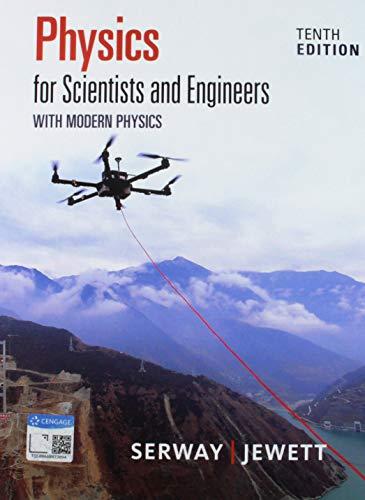
Concept explainers
(a)
Prove that the quantized radii of Earth’s orbit is
(a)
Answer to Problem 42AP
It is proved that the quantized radii of Earth’s orbit is
Explanation of Solution
The gravitational force between Earth and sun is balanced by the
Write the relation between gravitational force between Earth and sun and the centripetal force at equilibrium.
Here,
Write the equation for quantization of angular momentum of Earth.
Rewrite the above relation in terms of
Rewrite equation (I) by substituting the above relation for
Rewrite the above relation inn terms of
Therefore, it is proved that the quantized radii of Earth’s orbit are
(b)
The numerical value of
(b)
Answer to Problem 42AP
The numerical value of
Explanation of Solution
Rewrite equation (II) in terms of
Conclusion:
Substitute
Therefore, the numerical value of
(c)
The distance between orbits corresponding to quantum number
(c)
Answer to Problem 42AP
The distance between orbits corresponding to quantum number
Explanation of Solution
Write equation (II) for the radius corresponding to quantum number
Here,
Rewrite the above equation by substituting
Here,
Subtract equation (III) from equation (IV) to find the separation between orbits.
Neglect the value
Conclusion:
Substitute
Therefore, the distance between orbits corresponding to quantum number
(d)
Importance of results obtained part (b) and (c).
(d)
Answer to Problem 42AP
Since the separation between orbits is too small in comparison with the radii of atomic nuclie, it is impossible to observe the quantized orbits of Earth.
Explanation of Solution
The result obtained in part (c) is
Therefore, since the separation between orbits is too small in comparison with the radii of atomic nuclie, it is impossible to observe the quantized orbits of Earth.
Want to see more full solutions like this?
Chapter 41 Solutions
Bundle: Physics For Scientists And Engineers With Modern Physics, 10th + Webassign Printed Access Card For Serway/jewett's Physics For Scientists And Engineers, 10th, Multi-term
- Derive an expression for the ratio of X-ray photon frequency for two elements with atomic numbers Z1 and Z2.arrow_forwardFor an electron in a hydrogen atom in the n=2 state, compute: (a) the angular momentum; (b) the kinetic energy; (c) the potential energy; and (d) the total energy.arrow_forwardWhat is the de Brogue wavelength of a proton whose kinetic energy is 2.0 MeV? 10.0 MeV?arrow_forward
 Principles of Physics: A Calculus-Based TextPhysicsISBN:9781133104261Author:Raymond A. Serway, John W. JewettPublisher:Cengage Learning
Principles of Physics: A Calculus-Based TextPhysicsISBN:9781133104261Author:Raymond A. Serway, John W. JewettPublisher:Cengage Learning Modern PhysicsPhysicsISBN:9781111794378Author:Raymond A. Serway, Clement J. Moses, Curt A. MoyerPublisher:Cengage Learning
Modern PhysicsPhysicsISBN:9781111794378Author:Raymond A. Serway, Clement J. Moses, Curt A. MoyerPublisher:Cengage Learning
 Physics for Scientists and Engineers with Modern ...PhysicsISBN:9781337553292Author:Raymond A. Serway, John W. JewettPublisher:Cengage Learning
Physics for Scientists and Engineers with Modern ...PhysicsISBN:9781337553292Author:Raymond A. Serway, John W. JewettPublisher:Cengage Learning Glencoe Physics: Principles and Problems, Student...PhysicsISBN:9780078807213Author:Paul W. ZitzewitzPublisher:Glencoe/McGraw-Hill
Glencoe Physics: Principles and Problems, Student...PhysicsISBN:9780078807213Author:Paul W. ZitzewitzPublisher:Glencoe/McGraw-Hill University Physics Volume 3PhysicsISBN:9781938168185Author:William Moebs, Jeff SannyPublisher:OpenStax
University Physics Volume 3PhysicsISBN:9781938168185Author:William Moebs, Jeff SannyPublisher:OpenStax





